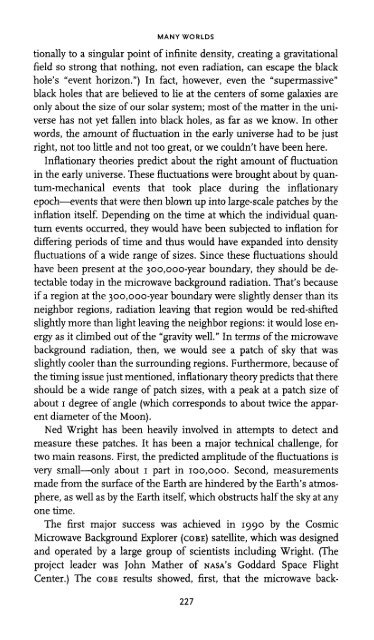Create successful ePaper yourself
Turn your PDF publications into a flip-book with our unique Google optimized e-Paper software.
HERE BE DRAGONS<br />
pounds present in the star's outer layers. It was the collective shift of<br />
all these bands toward longer or shorter wavelengths that Queloz and<br />
Mayor set out to measure. They did this by comparing the star's absorption<br />
bands with the absorption bands in the light coming from a<br />
lamp, which obviously were not Doppler shifted.<br />
Several other astronomers had been using the radial velocity approach<br />
for several years before Queloz and Mayor commenced their<br />
observations. These others included two Canadians, Bruce Campbell<br />
and Gordon Walker of the Dominion Astronomical Observatory in<br />
Victoria, as well as two astronomers at San Francisco State University,<br />
Geoff Marcy and Paul Butler (Butler is now at the Anglo-Australian<br />
Observatory in Sydney). Aside from a couple of false alarms, none of<br />
these scientists had succeeded in detecting any planets. What Queloz<br />
and Mayor had going for them, however, was a sophisticated piece of<br />
analytical software that very rapidly calculated the Doppler shift of the<br />
source while the star was still under observation. Marcy and Butler's<br />
spectra, on the other hand, had to be processed off-line, and in fact<br />
they had accumulated several years' worth of unanalyzed spectra<br />
when the Swiss researchers began their observations.<br />
Queloz and Mayor chose about 125 stars to study. They had masses<br />
similar to that of the Sun (so-called G stars) or slightly lower (K stars)<br />
Planets of Sun-like stars are often considered the best candidates for<br />
harboring life, so we ask Queloz whether the quest for life was a factor<br />
behind their choice of targets. He denies it. "They're just the easiest<br />
stars to study," he says. "The lower-mass stars are less bright, and the<br />
higher-mass stars don't have enough absorption bands to study."<br />
They set up their equipment at the Observatoire de Haute-<br />
Provence, just outside the medieval town of Forcalquier in the French<br />
Alps. Forcalquier's Romanesque Church of Notre Dame dates back to<br />
the era when Scholastic philosophers attempted to solve the problem<br />
of "other worlds" by the power of thought alone. Queloz and Mayor resolved<br />
the problem empirically in July 1995, when they detected a<br />
large planet circling a star called "51 Pegasi" (usually abbreviated to "51<br />
Peg"). It is the fifty-first in a list of stars in the constellation Pegasus.<br />
Queloz and Mayor had actually first noticed the variation in the radial<br />
velocity of 51 Peg six months earlier. But the data were so unexpected<br />
that they hesitated to believe them. For 51 Peg was moving to<br />
and fro with a periodicity of only 4 days, and yet the amplitude of the<br />
velocity change demanded a planet at least half the mass of Jupiter. If<br />
the data were real, it meant that a Jupiter-like planet was orbiting its<br />
114













